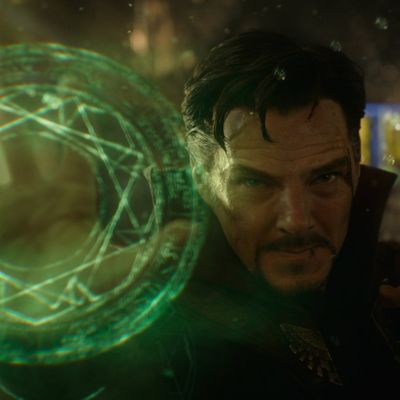
Most superhero pictures are CGI-cluttered eyesores, but the new Doctor Strange has a dazzling, kaleidoscopic palette that compensates for the usual thin-ish story featuring A-list actors zapping one another, along with a hero who looks fearsomely witty even in repose.
Created by Steve Ditko, Dr. Stephen Strange is not the most famous or distinctive of the Marvel characters, but thanks to Benedict Cumberbatch he might be the most entertaining. It wasn’t so long ago that Cumberbatch’s lizard-like physiognomy seemed strange, indeed. But we’ve grown accustomed to his face, which makes those of other leading men look blandly proportional. In Doctor Strange, his slanted, wide-apart eyes fit the film’s geometry. He’s like a Picasso figure striding through a cubist universe — a place where walls can split into hard shards and open out like the Red Sea. Cumberbatch’s Strange parts the material world like a Picasso Moses.
When we meet him, he’s a neurosurgeon, the best on Earth in his humble opinion, which makes him insufferable to his colleagues and his ex-girlfriend, fellow surgeon Christine Palmer (Rachel McAdams). But this supreme egotist drives his car off the road, disintegrating the bones in his hands along with his identity. He can’t even get people to call him “Doctor,” anymore. (The movie doesn’t mention there are plenty of ways to be a functional M.D. without doing surgery — but never mind.) As his ego shrinks, Strange comes to see himself as a “tiny speck in an indifferent universe.”
But the Marvel universe is anything but indifferent: It has a wicked sense of humor. Under the tutelage of a Nepal-based bald woman of indeterminate origin called the Ancient One (Tilda Swinton), Strange must accept that his former sense of mastery was an illusion, that one can’t beat a river into submission but instead surrender to its current, that there are an infinite number of universes, and that the spirit exists apart from the body in a timeless and immaterial realm. Yes, it’s a lot of “forget-what-you-think-you-know” Matrix blather bolstered by Buddhist blah-de-blah, but it sounds great with the crisp diction of Swinton, whose dome seems to have been de-pored by computers to make it smooth as a baby’s butt. Meanwhile, the designers — production, makeup, costume, effects — make every bit of this nonsense sing.
The problem with CGI in Marvel movies is that it tends to be used so promiscuously that miracles become cheap. But when there’s a controlling idea the CGI can seem miraculous again. Doctor Strange takes off from Plato’s famous notion that the physical world is a reflection in a mirror — and here that mirror can be shattered and reassembled and shattered again, or compressed like an accordion, or turned funhouse-wavy so that buildings become giant Gumbys that fold in on themselves.
After Strange learns to spin flaming circles in the air and disappear into a spatial-temporal vortex, the film turns into a cosmic farce: The characters create their own doors for running in and out of. The most sustained sequence opens with Strange fighting the chief villain, former Ancient One protégé Kaecilius (Mads Mikkelson), in Nepal and ends with his “astral self” directing his ex-girlfriend to perform surgery on his physical self on an operating table in New York. Kawabunga! The director, Scott Derrickson, has previously given us nasty horror dreck like The Exorcism of Emily Rose and Sinister. This is a rare case in which Marvel has freed a director’s imagination instead of straitjacketing it.
Did I say A-list actors? A+ is more like it, although the brilliant Chiwetel Ejiofor has to over-muzzle himself as the Ancient One’s second-in-command, Mordo. (A post-credits teaser suggests he’ll have more colorful things to do in the next installment.) Most of what Mikkelson says is gobbledegook, but his delivery is so bone-dry that he makes a vaudevillian-style word mix-up gag sound like Oscar Wilde, and his look is inspired. His eyes seem to have been gouged out and replaced with smoky shards of glass, which are spookily of a piece with those inhumanly sharp cheekbones.
Above all there is Cumberbatch. His first scenes are too much out of the House playbook, and his from-nowhere American accent even resembles his countryman Hugh Laurie’s. But deprived of his normal, Sherlockian cadences, he seems abnormally vulnerable, and his attempts to control the time-space-continuum are small masterpieces of pantomime. Instead of a Thor-like hammer or Captain America-like Shield, Dr. Strange has a weaponized cape with a will of its own, and Cumberbatch is so skinny that the cape completes him. As he confidently strides into the terrifying “dark dimension,” we know he’ll be okay. His very spirit seems to billow.


